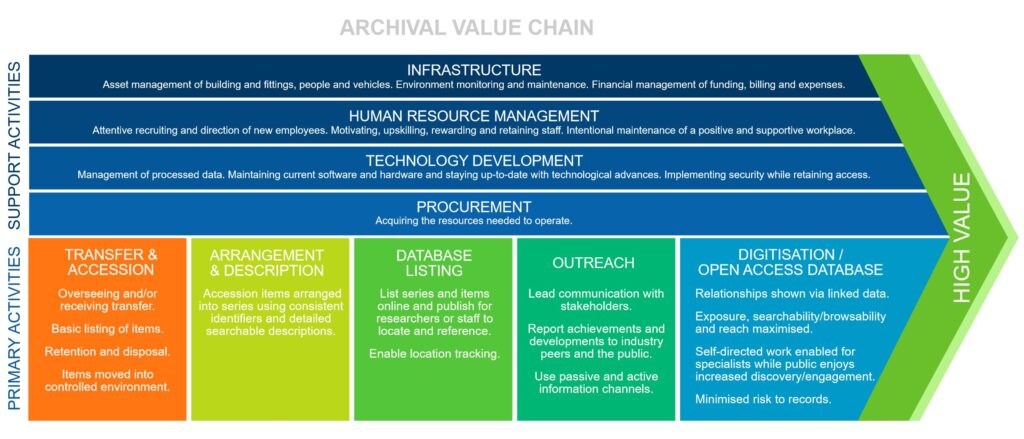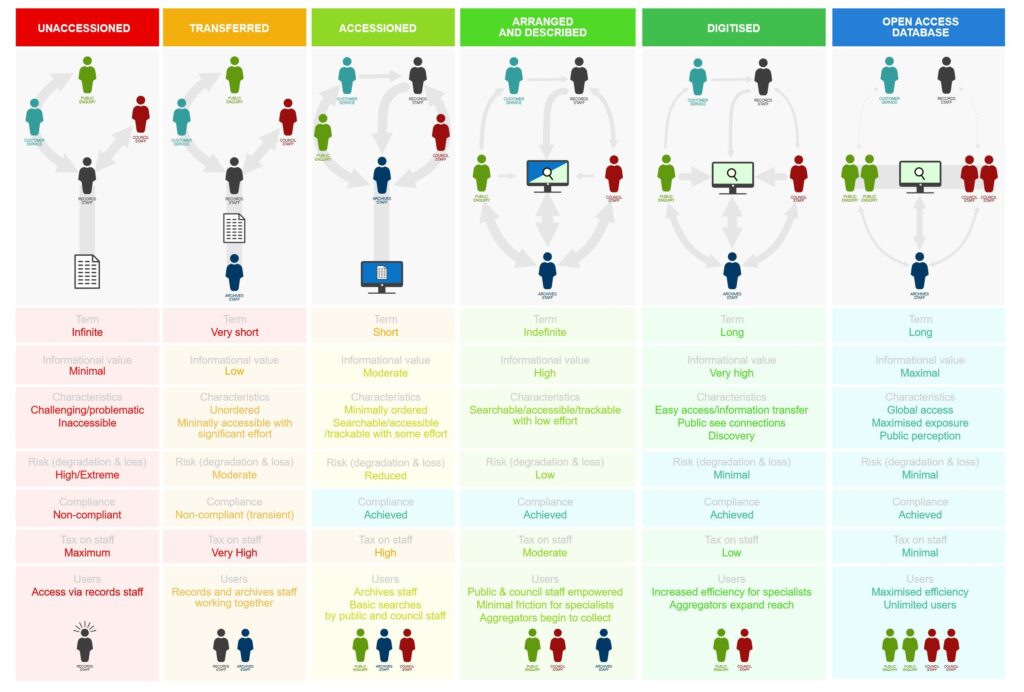Archives are more than just dusty storage spaces for old historical records that time and space has forgotten. They are now dynamic repositories of knowledge where, if utilised properly, can be used to feed the ever-increasing amount of AI platforms we continue to create in our organisations and businesses.
Preparing for the AI Future
Archives are more than just dusty storage spaces for old historical records that time and space has forgotten. They are now dynamic repositories of knowledge where, if utilised properly, can be used to feed the ever-increasing amount of AI platforms we continue to create in our organisations and businesses.
But how do you go from words written on paper to having AI providing you with intelligent output? To answer that question, we need to take a high-level look at our processes and how archives are valued.
How do Archivists add value?
Through the primary activities of the archival profession, archivists add value by following a logical chain of processes:
- Transfer & Accessioning: Undertaking sentencing decisions via Retention & Disposal, overseeing the physical transfer of records, and creating a basic accession list for previously unlisted records.
- Arrangement & Description: Accessioned records are removed and collated into a new or existing groupings (by series, provenance, subject/theme etc.); metadata is added to the minimum required for an accession.
- Database Listing: Creating basic listings of accessions and groupings of physical records; location tracking is enabled.
- Digitisation: Creating high-quality reproductions according to best-practice and standards; completing follow-up steps such as, Optical Character Recognition (OCR), metadata extraction and enrichment, transcription, creation of digital preservation formats, etc.
- Adding to Open Access Database: Exposing records to the web and conducting Search Engine Optimisation (SEO); adding to linked data & semantic tagging; applying Creative Commons (CC) licenses to records.
- Outreach: Communicate with stakeholders and organisations through various channels on archival holdings; keep GLAM sector and public informed on developments and project achievement

These archival processes are key to making information easier to find and use, for humans and machine alike. Let’s dig into a bit more detail on the right side of the diagram on how archival processes aid information accessibility in digital formats:
- Standardisation: Applying consistent metadata inputs via an adopted schema (such as the Metadata Object Description Schema or Dublin Core) enables AI and search engines to reliable and effectively retrieve information.
- Digitisation & OCR for Data Extraction: OCR can make historical texts machine-readable. Data extraction enhances discoverability and interoperability with other databases.
- Linked Data & Interoperability: Connecting archival records with national and global-level heritage organisations datasets leads to broader research applications.
- Data Integrity & Reliability: Ensures that AI consumes verified, high-quality information rather than unstructured or misleading data.
Reliable Data, Reduced Bias, Smarter Insights
As the born-digital era continues to rapidly expand, and AI continually shapes how we access and interpret information, the role of information management professionals has never been more critical. A well-maintained archive provides structured, authoritative sources that enhance the reliability of AI outputs. When archival records are digitised and added to databases, they offer historical accuracy, context, and provenance to bolster our current digital records.
One of the biggest challenges in AI development is reducing bias and misinformation. A notable example (amongst many) is Microsoft’s AI chatbot, Tay, which began expressing offensive remarks on social media due to learning from poor-quality data. Utilising untested or unreliable digital sources can distort AI-generated insights, reinforcing inaccuracies instead of correcting them. So too can incorporating only digital-born records into an LLM. AI output for an organisation with access to only the past 15 years’ worth of digital information would completely gloss over an organisation’s 100+ year history.
One of the real-world examples I use to show the transformation of archival information into tangible value is that of a bridge requiring major repairs. After receiving a request to find any and all information pertaining to this specific bridge spanning a major water way, I quickly found multiple records on a database of the original architectural plans from the early 1900s. These were then digitised and sent to the requestor, who replied,
Wow, you just saved us hundreds of thousands of dollars in invasive inspection and remediation!
Now, imagine the entirety of our collections digitised and online, with AI delivering the same results across all the teams in an organisation, all day, every day…
The Future of Archives in an AI-Driven World
So, where to from here? I can see quite a few positive outcomes, with my favourites listed below:
- Archival Processing: AI is another tool we can use to help us in our jobs. Increasing AI adoption and upskilling staff would lead to enormous productivity gains by supporting archival processes, especially digitisation, transcription, and metadata creation (with the caveat that human oversight and quality control remains crucial).
- Government & Private Sector Collaboration: Archivists already play an active role in increasing the openness and transparency of information. By partnering with other organisations to link entire collections and datasets, we can vastly expand the amount of information available to our AI platforms to output useful, useable information.
- Empowering Users: By leveraging the metadata, OCR, and linked data that archivists create, AI enhances discoverability and contextual understanding, making databases more intuitive more valuable and powerful. The quicker our users can search, analyse and retrieve information, the more efficient (and happier) they will be. This also further reduces requests and workloads on information management professionals.

The value of archives extends beyond historical preservation and the walls of heritage institutions. Well-maintained archives actively contribute to the digital knowledge landscape and will continue to do so as the exponential adoption of AI shapes how information is accessed and interpreted. Archivists must advocate for high-quality, structured archival records to ensure AI has reliable data sources. Investing in archival processes today will strengthen future research, discovery, and innovation.
The full chart of How the Archival Process Affects the Value of Information can be viewed via this link. Please credit Evan Greensides, Danya Anderson and Archives Central if reusing via the Creative Commons License (CC-BY-ND 4.0 License)
